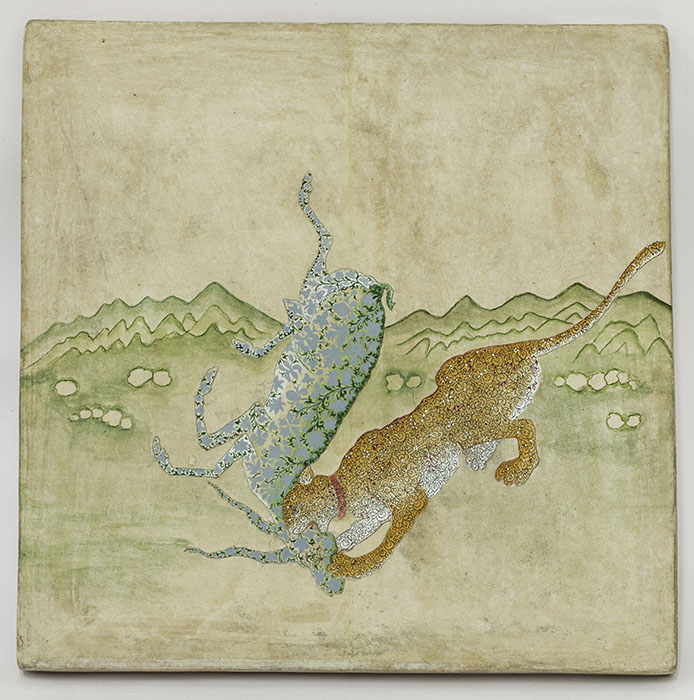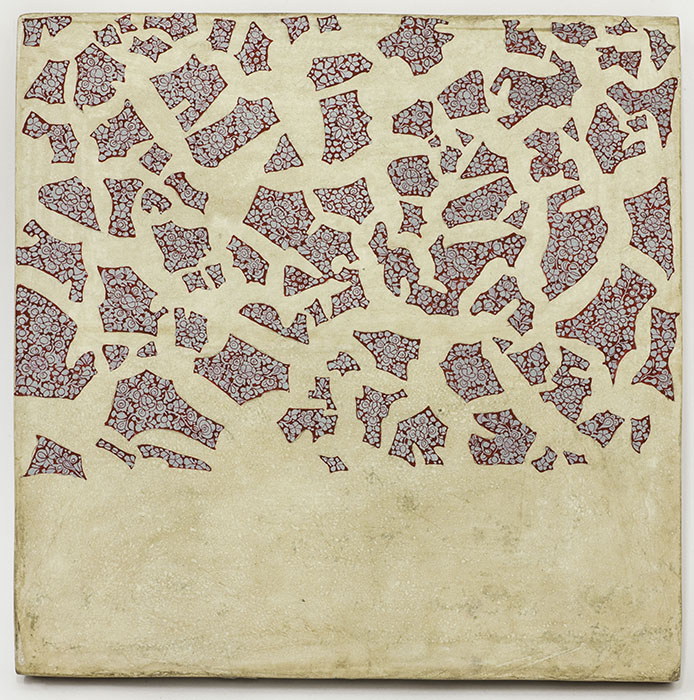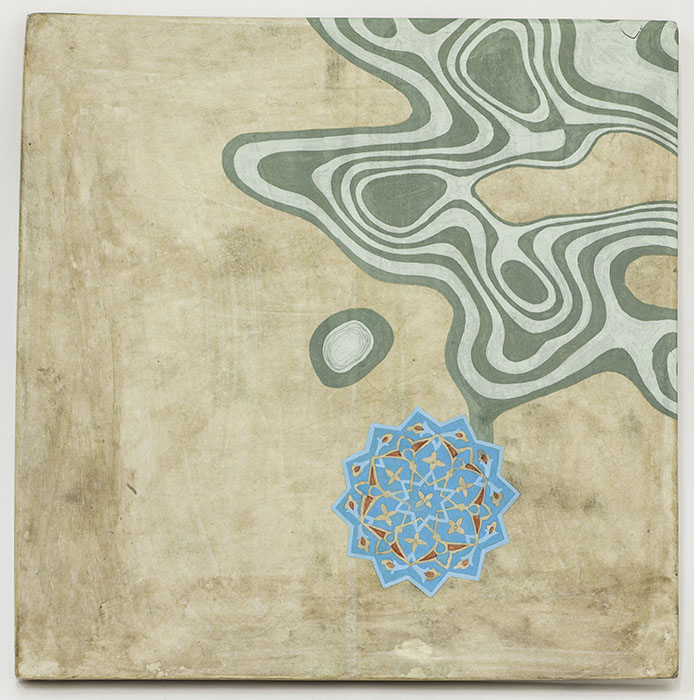The perennial misrepresentation of conflict-ridden Kashmir in the mainstream narrative led Praneet Soi to delve into the rich historical legacy of the city and develop an alternative, almost subversive version of the narrative. In a conversation with Pratiti Ganatra, he explains the influences and experiences behind the creation of his latest project.
In his latest project, ‘Srinagar’, Soi has collaborated with local craftsmen to create a body of work that moves away from the conventional and unremarkable perceptions that conflict zones like Kashmir have in the public domain. The project comprises of a series of papier-mâché tiles, designed especially for the artist, and a projection of a sequence of images that look closer into the well-embedded patterns at the Sufi shrines in Kashmir.

Could you tell us a little about this project? How did the idea come about?
This was something I’d been thinking about for a while because I was always interested in Kashmir. Everyone knows about the history of Kashmir—so I don’t need to go into that—but I was interested in what really happens over there and how life is lived over there now. My family is a Punjabi family that migrated from Lahore to Calcutta, so there is a history of migration. I first went [to Kashmir] in 2010, and spent about a week or 10 days in the winter exploring the city, exploring the environment, meeting people. I began to understand how there are a lot of things in contemporary Kashmir that no one hears about any more, because of the trouble. There is almost 2,000 years of history, if we go back—ancient Hindu times, Buddhism, and then there is the Sufi culture. So Islam enters the country largely through Sufi movements that come through Kashmir.
So that became interesting…and then to see what kinds of crafts flourished over there, what was happening in an area, which was very different because you have so many different waves of immigrations and migrations and cultures and religions. So that began to take over the narrative: what is really happening here now, rather than the media narrative. Today, when you picture Kashmir no one really thinks any more of the shrines that are there or the old temple above Srinagar. No one really goes to all these places any more, right?
It was once a very beautiful city. It is also home to a lot of water culture because of the lakes, and a lot of small canals. That began to interest me more and more. Then I found these craftsmen who make what we have been seeing from forever—these beautiful motifs painted on vases, so I began to ask who are they? You know, in every craft-based industry or city, it always gravitates from…there will always be one or two craftsmen who are the more adventurous. So I found Fayaz Jan, this craftsman I worked with.
Also, papier-mâché is an import, actually. It comes from Iran: 700–800 years of all this movement. So this papier-mâché technology, which we all think of as quintessentially Kashmiri, is actually an import from Iran. I began to see how it is done. You have different sets of craftsman making things—the craftsmen who make the papier-mâché are generally Sunni, while the craftsmen who paint are Shias, so that got interesting.
I asked them to make me these tiles. Rather than painting on these touristy things like the vase, I asked them to make the tiles of papier-mâché. It’s a very beautiful surface; it holds paint very well. So we used these series of papier-mâché tiles, which are then painted on by the craftsmen I worked with. I embedded myself in the studio, got to know their stories. I got to know that some images they know by memory because they have been painting them for years, some they still need to look at, some they have tracings of, which they rub on the surface and then paint. So I got to know how they worked, and then I created my compositions based on their designs, making it more experimental, playing with the frame, using aspects, not filling everything and leaving some space open. And I used a lot of the research that I did on the Sufi shrines when I went there, especially khanqah. I used colours I saw in there.

There has been a longstanding misrepresentation of Kashmir in the mainstream media. How have you tried to break away from this kind of misrepresentation?
I didn’t try and break away; it just happened. I just didn’t want to get stuck. I think there is a lot of misery there, and there are a lot of theories as to who is to blame. So it is a pity, because it is a very rich culture that you see over there and I feel that the people are losing a sense of their own history. And because of years and years of insurgency and war, life is tough over there. So I didn’t break away, I just found myself intuitively moving towards these areas as a painter, because I am a painter.

These conflict zones are often viewed from a one-dimensional lens—that it is a conflict zone. Do you think that Kashmir also suffered that? Are all conflict zones at risk of this?
Right, yes of course. It is one of the most militarised zones in the world, apparently. And when you talk to people—the army rules it largely, you know, the army is in charge. So now when tourism is slowly moving back, the airport is full again, you see. But no one is really going to the city anymore—to Srinagar itself—because it is considered a bit dangerous. People are just going to the hills and mountains.

How have you incorporated the idea of ‘migration’ in the art pieces?
I think for me it became about migration of patterns and forms—where these forms came from. So all these patterns migrated. I was recently on a scholarship at the Smithsonian in Washington and speaking to people that study Islamic patterns there, and they were saying that actually the route comes with Genghis Khan’s invasion of China and Central Asia, so that’s when you begin to see these forms beginning to happen: the clash of cultures and the clash of the war spreading, and people moving. You see this iconography beginning to emanate. And if you go back 600, 700, 800 years, you begin to see that these forms are actually very…it is a migratory path. It’s not like we think that Mughal miniatures are Mughal, it’s actually not. So this idea is also incorrect that some kind of form can be totally independent from outside influences. It is impossible; it is a fallacy. So that is what intrigued me over there. I would listen to their stories, I would constantly ask the craftsmen what they remember where a particular pattern was from. Of course, they don’t remember so much but I did a lot more research—I looked online, I was fortunate to get a fellowship at the Smithsonian and spent some time there understanding the movement.

Kashmir has had a very rich historical tradition of art and craft. How do you think this has evolved over the years? What are some of the elements you see in contemporary Kashmiri art that make it different in a way from what it was historically?
There are some artists doing interesting things, of course. But there are very few people going in there, and that’s a problem. There must be a lot of contemporary artists and I know some of them, but the problem there is not that. The problem is that it is becoming a bit remote…I mean now it is opening up again, it is getting safe, but for years there was not happening so much. Can you remember the last time you went to Kashmir?

It was, as you said, very recent…once the tourism opened up. Can you talk a little about this idea of asymmetry in your project? What does it signify?
I got interested in asymmetry because I am interested in how images have a life of their own. I see asymmetry also in a kind of an ideological way that you fight against an idea—not an ideological way, actually, but an anti-ideological one that you need to fight the hierarchy that comes with language. So it’s not just language, language has its hierarchy, be it the visual language or the spoken language. There is a kind of hierarchy that you want to play with, that you want to mess with and move away from a certain idea of grand or grandiose-ness.

How have you collaborated with the traditional crafts-people of Kashmir for this project? How have they been able to influence or contribute to it?
So it was the craftsman’s studio, the one I met…he works with five or six artists, so he is the ustaad. There is an interesting dynamic, because he works with a group of four or five people and they all have different skills. Some are older than him, some are younger than him and they all have a way of existing together—while he is the head, he is very careful how he treats them. I had to be very careful how I fit. I didn’t want to be this city person who’s coming in and using and abusing this position, because it was a position of trust, so it was important really understand the fabric of that relationship while inserting myself into it.
They are very used to working for the tourism market, and I didn’t want that. I wanted things that were more experimental, so how do you get to a position where they trust you, and where they are doing things that they don’t usually do? It is difficult for them. It was physically difficult because when they have their patterns sorted out, they know it, but if you want to do something different, you have to acquire a different skill level. You have to switch. If you have been drawing a pattern all your life, and someone comes in and says “draw me a different pattern”, it is much more difficult. You have to trace it out, which colour to use, how to use it—all these things required certain steps. And then I also had to change my thinking of how the end result would be. They would say “this is possible, this is not possible”. Or they would lose interest, and I would be like “Okay this is not working, let’s try something else.”

Why have you chosen these papier-mâché tiles as your medium? I mean, this was something that you hadn’t used before, so was this a need to be experimental?
For them working on papier-mâché is not experimental. They’ve always been painting on papier-mâché; they have that figured out. But they told me, “Why don’t you paint on a wood surface or plywood surface? You cut it out, it will be perfect. It will be very easy to work with.” But for me it was not interesting. Papier-mâché was so interesting on a symbolic level because of this journey from Iran in the Middle Ages, coming over from the mountains and being brought over by Shah Hamdani, who was this Sufi teacher who comes into Kashmir. He converts the Buddhist ruler at the time into Islam and then he begins to work there and explain to the local people how papier-mâché works. The craftsmen then began to experiment and till now it is embedded. So it is embedded but it is not endemic—it is not from Kashmir. Or even the idea of the leaf of the chinar tree. We think it is so Kashmiri, but it actually comes from Iran. Chinars were actually brought in from Iran.

Lastly, what is the role of art in society? Is it art’s duty to represent the truth? Does art have any moral obligations?
I won’t look at it through a moral prism, but definitely if you are involved in art, and if you can understand it or spend time with it, if you are making it or if you are a viewer, understanding it will give you a different perspective on the world. You know, it is like reading a good book. It may not necessarily make you a better artist or a better philosopher by reading it, but it will definitely give you a different perspective of life.

‘Srinagar’, Praneet Soi’s first solo show at the Experimenter, will be on view at the gallery till 30 May 2015.














